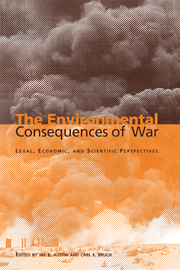Book contents
- Frontmatter
- Contents
- List of illustrations
- List of tables
- List of contributors
- Acknowledgements
- Foreword by Klaus Toepfer
- Introduction
- Part I General principles
- Part II The legal framework
- Part III Assessing the impacts – scientific methods and issues
- Introduction
- 11 Scientific assessment of the long-term environmental consequences of war
- 12 The Gulf War impact on the terrestrial environment of Kuwait: an overview
- 13 War-related damage to the marine environment in the ROPME Sea Area
- 14 War and biodiversity: an assessment of impacts
- Introduction
- 15 Tracking the four horsemen: the public health approach to the impact of war and war-induced environmental destruction in the twentieth century
- 16 Defoliants: the long-term health implications
- 17 The impact of military preparedness and militarism on health and the environment
- 18 War and infectious diseases: international law and the public health consequences of armed conflict
- Part IV Valuing the impacts – economic methods and issues
- Part V Prospects for the future
- Index
12 - The Gulf War impact on the terrestrial environment of Kuwait: an overview
Published online by Cambridge University Press: 04 August 2010
- Frontmatter
- Contents
- List of illustrations
- List of tables
- List of contributors
- Acknowledgements
- Foreword by Klaus Toepfer
- Introduction
- Part I General principles
- Part II The legal framework
- Part III Assessing the impacts – scientific methods and issues
- Introduction
- 11 Scientific assessment of the long-term environmental consequences of war
- 12 The Gulf War impact on the terrestrial environment of Kuwait: an overview
- 13 War-related damage to the marine environment in the ROPME Sea Area
- 14 War and biodiversity: an assessment of impacts
- Introduction
- 15 Tracking the four horsemen: the public health approach to the impact of war and war-induced environmental destruction in the twentieth century
- 16 Defoliants: the long-term health implications
- 17 The impact of military preparedness and militarism on health and the environment
- 18 War and infectious diseases: international law and the public health consequences of armed conflict
- Part IV Valuing the impacts – economic methods and issues
- Part V Prospects for the future
- Index
Summary
Introduction
Kuwait constitutes a portion of the northwestern coastal plain of the Arabian Gulf. It covers an area of approximately 17,818 km2, and is characterized by arid conditions, with an average annual precipitation of approximately 105 mm. Strong northwesterly winds prevail, particularly during spring and summer. The maximum wind speed is approximately 29 m/s and usually peaks in May. Summer is extremely hot, with temperatures peaking in July and August at an average of 45°C.
The population of Kuwait is 15 million (1995), with a maximum population density of 87 persons/km2. Oil, natural gas, groundwater, and fisheries are the major natural resources in Kuwait. As of 1994, oil production was approximately 2.1 million barrels/day. The production of natural gas reached 7.6 billion m3 in 1995.
The terrestrial ecosystem of Kuwait is comprised of a diversity of plant and animal species. Like most Arabian Gulf countries, Kuwait's land resources are used for livestock grazing, water production, oil production, and sand and gravel quarrying, as well as for agricultural production. Traditionally, the terrestrial environment has also been used during mild seasons for wildlife hunting (mainly for birds). During hot and dry periods, the soil becomes extremely vulnerable to wind erosion, particularly when it is disturbed or becomes barren.
During the Iraqi invasion and occupation of Kuwait, there occurred one of the worst man-made environmental disasters of all time. Personnel carriers moved across the desert lands destroying foliage, tearing up soil surfaces, and disrupting terrestrial habitats. Hundreds of kilometers of ditches were dug and thousands of makeshift shelters were constructed.
- Type
- Chapter
- Information
- The Environmental Consequences of WarLegal, Economic, and Scientific Perspectives, pp. 316 - 337Publisher: Cambridge University PressPrint publication year: 2000
- 7
- Cited by



